Levant
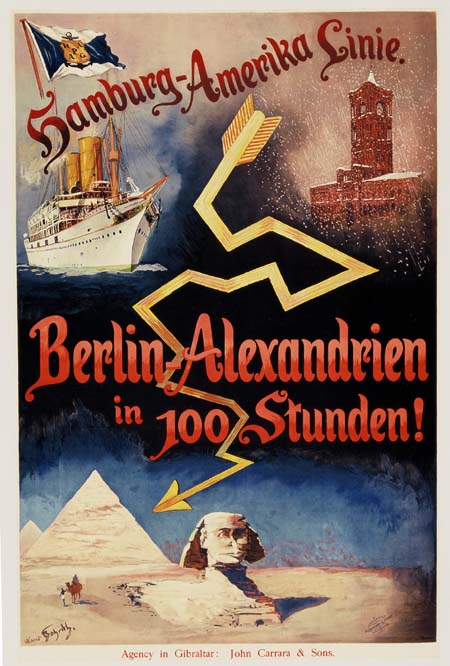 The "Oceana", painted by Hans Bohrd (coll. Juergen Klein)
The "Oceana", painted by Hans Bohrd (coll. Juergen Klein)
"Faces, bronze-coloured from sea-air and sun, with glowing black eyes, pale-faced German and British young ladies dressed in elegant traveling costumes, tall Englishmen slandering along with nonchalance or uttering sharp swear words, moving between groups of Greeks, Turks, Chinese, Germans, Italian and Albanian workers, East-Indians, orange and grape-selling women, seamen, fishermen, carriers dragging boxes and bundles, and porters of the neighbouring hotels, raged screaming black-eyed beggar and shoeshine-boys, all that is crowding the stony pavement, rolling up and down the inclined gangway from the steamer to the quay. And all that noise of human voices is being drowned out by the hissing of exhausting steam and the rattling of the chains of the ship's or the quay crane..."
That's the description of a P&O liner's departure at Brindisi, published by the weekly "Leipziger Illustrierte" in the 19th century
Struggle for the Indian Mail
Even before the "Savannah" crossed in 1819 the Atlantic, the British consul in Aleppo, John Barker, proposed steamship lines in the Mediterranean and the Black Sea. Then, during the steam age, British Admiralty, French steamers, Oesterreichischer Lloyd and in 1840 the P&O started services to Alexandria. British activities were strongly connected with the Indian Mail - see main chapter Indian Ocean.
Oesterreichischer Lloyd started in 1837 with a Trieste - Constantinople service. Already in the same year a branch line connected at the Greek island of Syros with Alexandria. In 1842 the British consul proposed an Indian Mail route via Trieste and "it seems evident (...) that these proposals were based on studies undertaken by the Foreign Office targeting to remove the Indian Mail from French control" (Oskar Stark: Eine versunkene Welt). At that time the Morning Herald and the Times had their own "races" across the Mediterranean and it was the pioneer Waghorn who took the chance of testing an overland route via Trieste. With mails for the Times, conveyed from Bombay by the "Semiramis" of the British Navy, Waghorn's couriers started on 19th October 1844 at Suez on horseback. At Alexandria Waghorn took over. Aboard the Austrian steamer "Ibero" he reached Duino near Trieste. Crossing the continent by stage coach, Rhine steamer, from Cologne by a "special" train of Rheinische Bahn and by Belgian Railways to Ostend, he arrived in London two days ahead of his competitors of the Morning Herald on the Marseilles route. France answered by offering a navy steamship and Waghorn proposed six other tests. On 22th September 1846 the first race across the Mediterranean and Europe could start. Waghorn reached London on 3rd October, his competitors on 7th. The second race was won by the Marseilles route with help of the new fast P&O steamer "Ariel", the third race ended drawn, the fourth and fifth in favour of Waghorn, the sixth drawn once again. Regular direct services Trieste - Alexandria were opened by the Oesterreichischer Lloyd on 10th May 1848, according to Oskar Stark. In 1852/53 the new paddle steamers "Bombay", "Australia" and "Calcutta" took up service on a fast Alexandria line - but the regular Indian Mail remained with the Marseilles route, conveyed by the P&O.
A portion of the Indian Mail took the railway to Brindisi for the first time in 1869. From Brindisi the mail was carried by steamers of the Societa Anonima Italiana de Navigazione Adriatico Orientale until in 1870 the conveyance was taken over by P&O. In 1890 the connecting CIWL de-Luxe train Peninsular-Express Calais - Brindisi started (see www.trains-worldexpresses.com). In 1898 the P&O introduced the fast steamers "Isis" and "Osiris", running Brindisi - Port Said.
Nevertheless Oesterreichischer Lloyd was always eager to get British passengers and mails for India and therefore the fast line Trieste - Alexandria changed its port-of-call from Corfu to Brindisi. In 1910 the new bright steamers "Wien" and "Heluan" were introduced on that route. Oskar Stark mentioned takeover of British mail for Egypt at Brindisi. Historian Dr. A. Kuntzemueller described also conveyance of the Indian Mail via the harbour Trieste in 1911 on account of the Italian-Turkish war. Generally however, the renowned Indian Mail historian Col. C.N.M. Blair had informed the author, that "letters which took the way via Trieste and Germany were very scarce".
Between 1885 and 1900 a CIWL de-Luxe train Ostende-Wien-Triest-Express connected at Trieste, from 1897 with a sleeping-car for Fiume, but in 1900 south of Vienna the sleepers were attached to ordinary trains. From 1909 the new Tauern railway shortened the way from the northwest to Trieste and for 1911 Oesterreichischer Lloyd wanted introduction of a CIWL de-Luxe Paris - Tauern - Trieste, but the proposal was rejected. From that winter the Simplon-Express Paris - Venice got a sleeper for Trieste. For the wealthy tourists arriving in Alexandria a special Lloyd Express waited near the quay, bound for Cairo, where they could board a Nile steamer of Cook & Son.
Early Competitors Europe - Egypt
In 1835 the French parliament decided for a government-owned passenger and mail line Marseilles - Livorno - Naples - Messina - Malta - Syros - Smyrna (Izmir) - Constantinople (Istanbul) with a branch line from Greece to Alexandria. The first ship to open the service on 1st May 1837 was the "Scamandre", described as a steamer of "truly royal luxury". In 1851 the Compagnie des Services Maritimes des Messageries Nationales was founded. They took over the steamers "Hellespont", "Bosphore" and "Oronte" of the company Bruno-Rostand and 13 state-owned mail steamers. In 1852 the iron 350-ton "Pericles" and in 1853 the 439-ton "Thabor" were put in service, but the next new steamers had to be employed in the Crimean War. In 1862 the first Indochina mail transport without British assistance was provided by the company, now named Messageries Imperiales, with the "Neva" on the Marseilles - Alexandria route. After 1871 the company was known as Messageries Maritimes.
P&O and the Asian liners of other companies later called only at Port Said, the entrance of the Suez Canal, at that time described as the most notorious harbour city of the Mediterranean. After 1881, the Rob. M. Sloman Co. changed with their Australia-Sloman-Linie to the Mediterranean route, but from 1886 Norddeutscher Lloyd (NDL) dominated the German mail business. In order to shorten traveling time, passengers were expected to use a NDL feeder line Trieste - Brindisi - Port Said, opened in 1886. However, they didn't approve to change steamer and therefore the branch line was confined in 1887 to Brindisi - Port Said, mainly for mail, and in 1893 it was abandoned. Instead, NDL's Asia steamers called from 1887 at Genoa. From 1893 also Naples became a port-of-call for NDL steamers.
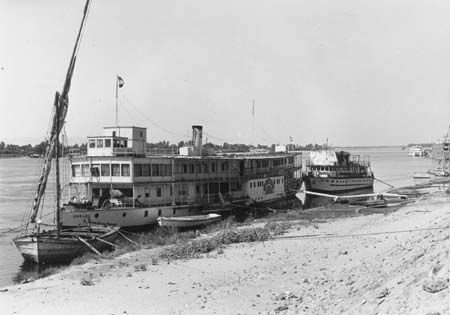
Historic Nile steamer "Sudan", Luxor 1979 (WS)
|
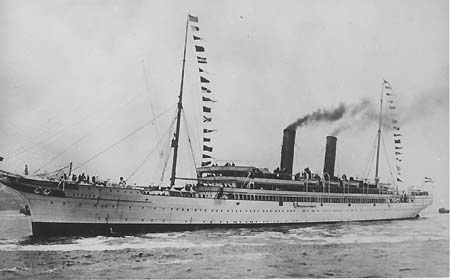
"Oceana" of Hapag (archives Hapag-Lloyd)
|
In 1905 Hapag participated in the Anglo-American Nile Steamers & Hotel Co., which then changed its name into The Hamburg & Anglo American Nile Co. In 1906 a seasonal fast line Naples - Alexandria was opened. Cruises of the "Prinzessin Victoria Luise" had been succeeded by services with the "Oceana" (7,815 gt, ex "Scot" of Union Castle), but in winter 1907/08 she was withdrawn in favor of a cooperation with a new enterprise. Ships Monthly (Nov.2010) described it as "the Egyptian Mail Steam Ship Co., which operated between Marseilles and Alexandria (...) and, within a year of beginning steamship operations, it had closed down, and its two brand new vessels, "Cairo" and "Heliopolis", had been laid up in December 1908." With almost 12,000 tons and a speed of 19 knots, the ships proved uneconomic for this route and they were sold to the Royal Line of Canada for North Atlantic services (see the relevant chapter). In January 1907 started a seasonal CIWL de-luxe train Aegypten-Express Berlin - Naples in combination with the Nord-Sued (Brenner)-Express and under contract with Hapag, connecting at Naples with the steamers. From 1910 (according to railway historian Dr. Albert Muehl) connection was with NDL, until 1914. Norddeutscher Lloyd had in 1904 introduced a Barcelona - Marseilles - Naples - Alexandria service.
Before WWI, Alexandria was connected also by the Moss Steamship Co. and Papayanni & Ellerman Lines of Liverpool, by the steamers of Prince Line coming from Manchester, by Messageries Maritimes, Norddeutscher Lloyd, Societa Marittima Italiana, The Navigazione Generale Italiana, from 1881 successor of Florio and Rubattino, served Alexandria from Venice, before they concentrated on transatlantic services from 1910 onward.
Europe - Egypt between the Wars
After WWI, Oesterreichischer Lloyd became replaced by Lloyd Triestino. The flagship "Wien" of the Alexandria route, renamed "Vienna", received a festive welcome when she arrived at Alexandria in spring 1921 with the Egyptian delegation on board, which just had signed the treaty of independence in Paris. In 1933 Lloyd Triestino introduced its proud two-funnel 13,062-ton motor-ship "Victoria", officially described as a luxury liner Trieste - Alexandria, but listed with Far East services. In 1937 the re-organized Lloyd Triestino got still more importance with takeover of the Far East services of 'Italia' Flotte Riunite. With the reorganization, Adriatica took over Eastern Mediterranean services from Lloyd Triestino. The fleet included even the old "Marco Polo", the former flagship "Kaiser Franz Joseph I" of Unione Austriaca. Luxury expresses were listed by the timetable of 1937 on the routes from Genoa and from Trieste to Alexandria.
About Greek activities in the Eastern Mediterranean, Laurence Dunn informed: Before, Greece used second-hand ships, except the "Syria" (later "Andros", 2,000 gt) of Empiricos Bros., built in 1914. In 1926 the Byron Steam Ship Co., a British subsidiary of Embiricos Bros., introduced the new "Patris II" (6,000 gt, 14 knots) on a route Marseilles - Corinth - Piraeus - Alexandria - Beirut - Istanbul, then transferred to the existing National Steam Navigation Co. of the same family, but in 1935 sold to Svenska Lloyd as "Patricia", after Embiricos became closed down. Also the Ionian S.N.Co., Mantufounis, Pantaleon, Pantelis, Kyriakidos, Aggelakos, from 1928 Typaldos and from 1929 mainly AKTEL served Egypt. There had even been a Greek attempt to participate in the traffic England - Egypt, possibly offering a new Indian Mail route. Vasilis Leondopoulos, later Greek railways' CEO, told the author that towards the end of the '20s the Simplon-Orient-Express from Paris was extended to Piraeus quay in order to connect with a fast Greek steamer for Egypt, unsuccessfully however.
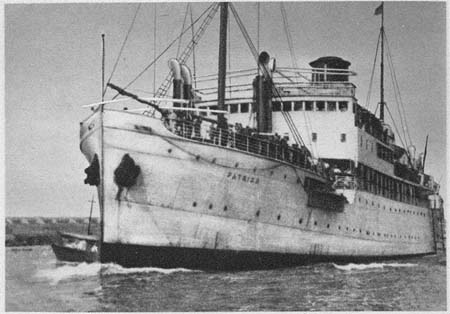
"Patris II" of Byron SS Co (coll. Leondopoulos, WS)
|
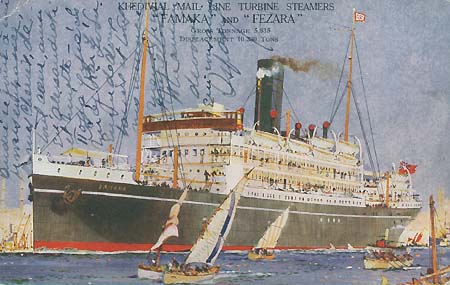
"Famaka", Khedivial Mail Line (postcard of the 20s, coll. WS)
|
Levant before WWII
The General Screw Steam Shipping Co., formed in 1848 as a successor of Laming and Smith, engaged in the trade between England and the Netherlands, commissioned the "Bosphorus", "Hellespont" and "Propontis" for Levant services, but soon transferred its interest to the Australia trade. The oldest timetable available, Hendschel's Telegraph of 1856, showed a French Syrian line Alexandria - Jaffa - Beirut - Tripoli - Rhodes - Constantinople. Towards the end of the 19th century, Messageries Maritimes was listed with an Alexandria - Beirut service, Oesterreichischer Lloyd had operated two different branch lines Alexandria - Jaffa - Beirut - Constantinople.
Before WWI, Bradshaw's timetable listed services to Constantinople by Messageries Maritimes, Oesterreichischer Lloyd, Russian Steam Navigation Co., the Romanian state line Serviciul Maritim Rouman, Societa Italiana, Hellenic and Panhellenic. The Khedivial Mail Steam Ship & Graving Dock Co. (see chapter Arabia) opened in 1896 services between Constantinople, Piraeus, Alexandria, Port Said and Beirut. In connection with the Orient-Express it was a way from Europe to Egypt. For Romanian and Russian services see chapter Black Sea.
The island of Cyprus, in the 16th century occupied by the Osmans, came under British rule in 1878. Prince Line offered Manchester - Cyprus services and Minotto, also a British company, ran from Alexandria to Cyprus. The timetable of 1914 listed services to Cyprus from Egypt by Khedivial Mail, from Beirut by Messageries Maritimes and from Mersin in Turkey by Oesterreichischer Lloyd. The port mentioned was Larnaca. A 2ft6in narrow-gauge railway to the capital Nicosia was opened in 1905, starting from Famagusta, another port. Historian Kalla-Bishop reported: "Until 1937, there was a fast boat train once a week in and out of Famagusta in connection with a mail steamer which called there, but this ceased when the steamer's call was transferred to Limassol".
After WWI Palestine became a British and Syria a French protectorate. Palestine meant for a growing number of Jews the country of their ancestors, where they wanted to migrate, especially after their discrimination began under Hitler. For that purpose Arnold Bernstein of Hamburg, who had bought the Red Star Line in 1934, started c. 1935 the Palestine Shipping Co. of Haifa, providing services Trieste - Haifa with the "Tel Aviv". In 1938 however British authorities stopped immigration. In Germany, Bernstein was arrested and expropriated. The German DR timetable e.g. of 1939 mentioned a service between Constanza and Haifa by the Palestine Maritime Lloyd Ltd of Haifa with the "Har Zion".
Messageries Maritimes chartered in 1932 the nice three-funnel 11,996-ton "Providence" and "Patria" of Fabre Line for their Marseilles - Egypt - Levant service and bought them in 1940. In the same year the "Patria" sank at Haifa, caused by sabotage. Then the services were stopped on account of World War II.
The Khedivial Mail Line was in 1920 acquired by P&O, but bewared its identity. The company praised in the 30s services with the "Khedive Ismail" and "Mohamed Ali el-Kebir". The timetable listed an Egypt-Cyprus Mail Line, an Egypt-Palestina-Syria Line and a service Alexandria - Port Said.
Israel's Start
After WWII once again the map changed. British troops left Egypt in 1947. Lebanon achieved independence. Jews who survived the holocaust tried to settle in Palestine. The British Navy stopped migrants' ships and the "Exodus" made history in 1947. That former "President Warfield", a tourist steamer of 1928, measuring only 700 tons, was cramped with 4,500 people no longer willing to be prevented from going to the Land of Promise. The Navy stopped her, but the people did not surrender, warships rammed the little boat, several passengers died and only when the "Exodus" threatened to capsize, the captain gave up. The Navy carried the refugees to British-occupied Northern Germany, where they were accommodated in a former concentration camp before they were released. Between 1945 and 1948 the Jewish Agency for Palestine had bought 64 ships for conveying people to the land of their forefathers. Finally, on 14 May 1948, the representatives of the Jewish organizations proclaimed in Tel Aviv the independent state of Israel and appointed Chaim Weizmann to their first president. Muslims living there were not expelled.
Israel's dominant shipping company became known as Zim Lines (see chapter North Atlantic/ Levant). A predecessor of it had been constituted already in 1945. For services Haifa - Genoa - Marseilles the Medem Line was established in 1947. Ships & Vessels was engaged in the immigrant traffic. By reorganization and amalgamation in 1948, Zim Lines was created, until 1953 confined to Mediterranean routes. Later among their trans-oceanic steamers at least the "Theodor Herzl" and Jerusalem" were used also on Marseilles - and Naples - Haifa routes. The port of Haifa had outranked the old Jaffa and sometimes a special train from Tel Aviv connected with the steamer. Somerfin Car Ferries intended to start in 1965 services from Haifa with the newbuild "Nili", but she was chartered by Finnlines, sporting the label "Helsinki Express". In 1966 the ship was chartered by the Arison Shipping Co. of Miami, but the development continued in another way (see chapter Cruises). Zim Passenger Lines (1970) Ltd listed the car ferries "Dan" and "Nili" on a Marseilles - Piraeus - Limassol - Haifa route as their only service. When they were laid up at Haifa in 1974, Israel's passenger services ended.
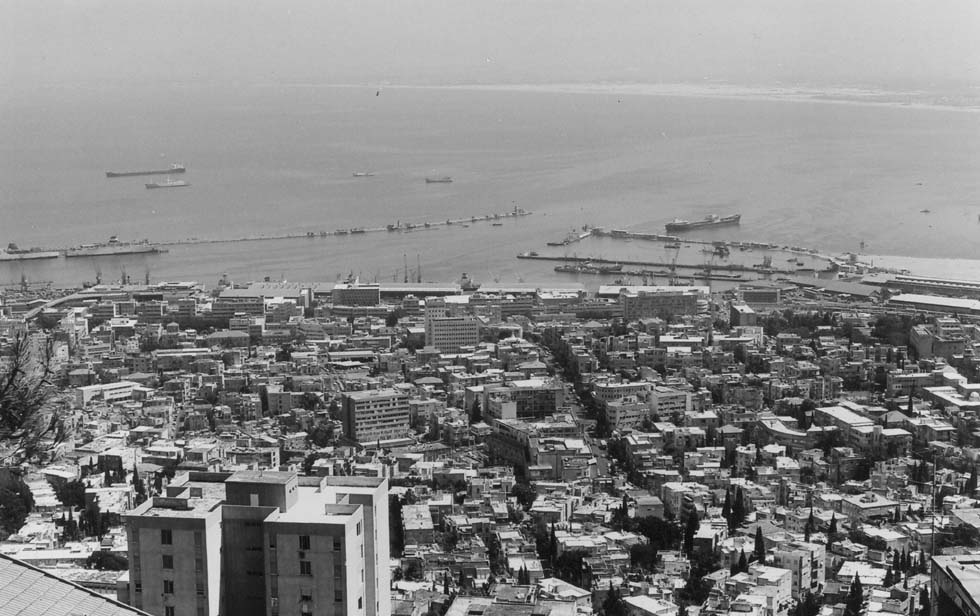
Haifa in 1974, seen from Mount Carmel, in the background (left) "Dan" and "Nili", laid up (WS)
Other Post-War Services
The history of the Eastern Mediterranean was not favorable to the development of commerce, though Greece and Turkey joined NATO. In Egypt the royalty was overthrown by General Nagib. After the new Egyptian President el-Nasser took possession of the Suez Canal, England, France and Israel started in 1956 their 'Suez Adventure', a failed colonial war. The USA arranged peace in favour of Egypt, but the series of Mideast wars continued. Lebanon became a place of civil wars, started in 1975 and ruining the country for decades.
Messageries Maritimes had resumed Levant services and one of their steamers, the pre-war "Providence", was used from 1949 also for pilgrims' voyages Dakar - Casablanca - Jeddah. In December 1952 the 12,262-ton "Champollion", during decades employed on the Marseilles - Alexandria - Jaffa - Beirut route, ran aground at Ras-Beirut in a stormy night. Finally the pilots of Beirut could save most of the passengers, but the ship was lost. Turkish Maritime Lines employed in the late 50s the steamers "Iskenderun" (6,570 gt) and "Samsun" on a route Barcelona - Alexandria - Istanbul and the motor-ship "Marmara" (6,042 gt) between Istanbul and Haifa.
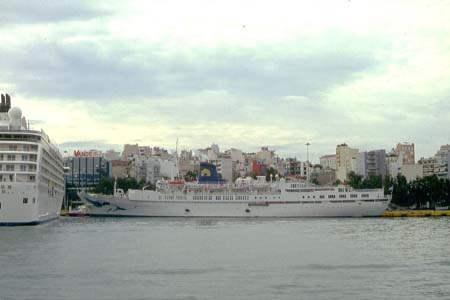
"Aegean Two", ex "Ausonia" of Adriatica, Piraeus 2007 (WS)
|
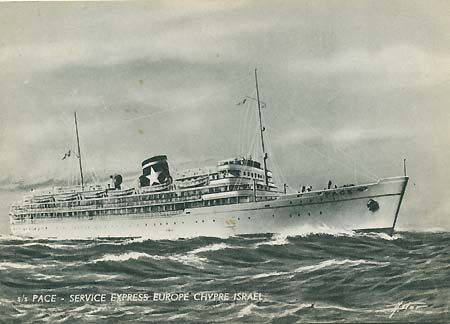
"Pace" of Ignazio Messina (old card, coll. WS)
|
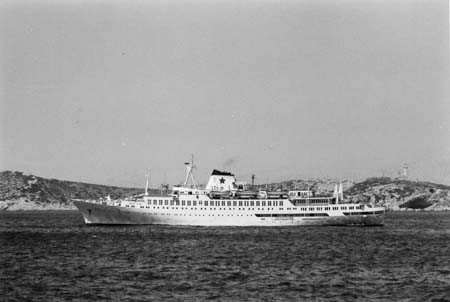
"Istra" of Yugoslavia, Salamis 1977 (WS)
|
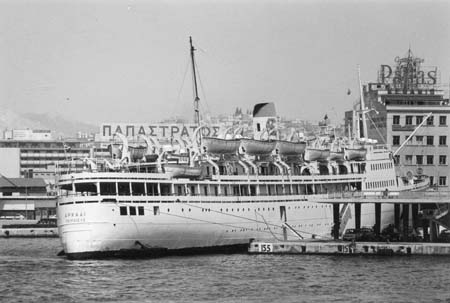
"Arkadi" of Efthymiades, Piraeus 1972 (WS)
|
Among the providers of services, car-carrying or not, in the Eastern Mediterranean during the decades to follow were the Cie. Francaise de Navigation, a daughter of Navigation Paquet, with the nice motor-ship "Renaissance" (11,724 gt, still in the 21st century cruising as "Blue Monarch"). Adriatica appeared with the beautiful motor-ships "Ausonia" (1957/11,879 gt, in 2004 reactivated by Louis Cruise Lines as "Ivory", then "Aegean II"), the "Victoria" (11,965 gt, built in 1953 for Lloyd Triestino) and the "Esperia" (9,314 gt) on the Alexandria route, as well as the car ferries "Espresso Cagliari" and "Espresso Livorno". Other operators were Ignazio Messina & Co of Genoa, Sitmar, founded in 1938 in Italy, Jadranska (then Jadrolinija) of Yugoslavia with the "Dalmacija" (1965/,5,500 gt) and sister "Istria", Hellenic Mediterranean Lines with steamer services also from Marseilles, Typaldos with the steamer "Atlantica" (13,803 gt, the former "Colombie" of CGT), Epirotiki Lines with the "Pegasus" and "Hermes" (the former "Princess Joan" and "Princes Elizabeth of Canadian Pacific's Victoria Island service), Nomikos, Potamianos, Dorian Cruises with the 5,500-ton "Agamemnon" and "Achilles" (at that time the largest ships being capable of passing through the Canal of Corinth), Efthymiades Lines, Afroessa, Stability Lines, Libra Maritime, Chandris with the 10,603-ton "Regina" (the former "President Hover"), Maritime Co. of Lesvos, Hadjioannou Lines Cyprus Cruises, Sol Maritime (their "Sol Christiana", the former "Juan March" of Trasmediterranea, became the "Kypros Star" of Opale Lines and then the cruise ship "Ocean Majesty"), Phineas Navigation with the former "Empress of Australia", Access Ferries with the "Takachiho Maru" (bought from Japan), Salamis Lines of Cyprus with the "Salamis Glory" (originally the Brazilian coastal ship "Anna Nery"), New Olympic Ferries employing the "Ambassador" (ex "Prins Oberon") on a Cyprus - Bari service, Med Sun Lines, Demline of Lebanon and other ones.
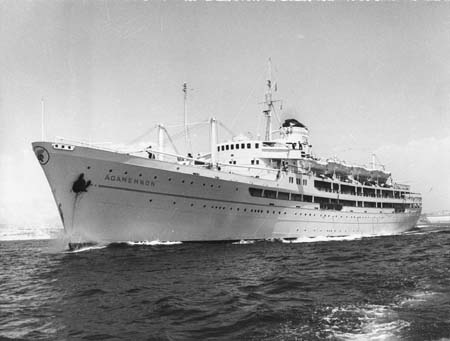
"Agamemnon" (old picture, coll. WS)
|
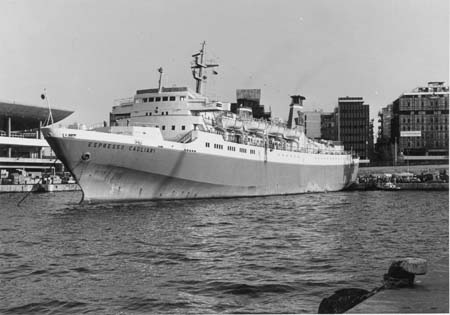
"Espresso Cagliari" of Adriatica, Piraeus 1979 (WS)
|
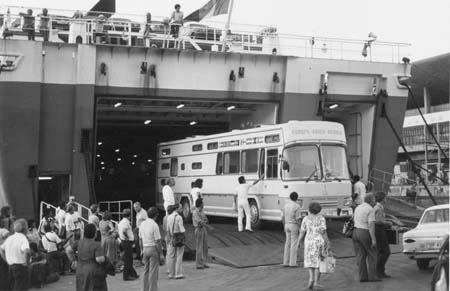
"Espresso Cagliari" loading a German bus, Piraeus 1979 (WS)
|
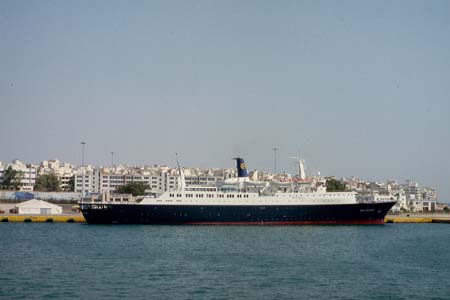
"Blue Monarch", ex "Renaissance", "Homeric Renaissance", Piraeus 2008 (WS)
|
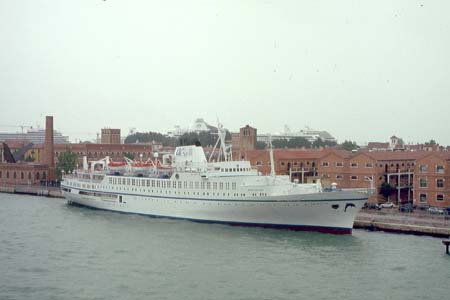
"Dalmacija", formerly of Jadranska, Venice 2008 (WS)
|
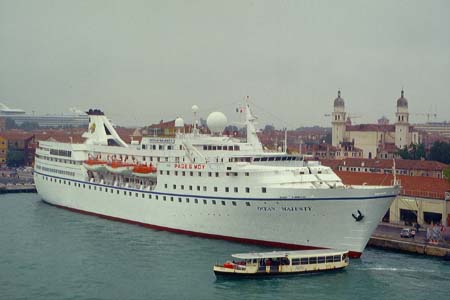
"Ocean Majesty", ex "Juan March" of Trasmediterranea, "Sol Christiana" of Sol Lines, "Kypros Star" of Opale Lines, Venice 2005 (WS)
|
Dreams...
Intended for a quite different clientele was a service for the wealthy tourists arriving at Venice by the nostalgic special train "Venice Simplon-Orient-Express", started by James B. Sherwood, owner of the Sea Containers Group. From 1986 they could board at Venice the comfortable car ferry "Orient Express" of Sealink UK, owned by Sea Containers Ltd, and go to Piraeus, Istanbul and Kusadasi in Turkey. The "Orient Express" (12,343 gt) was the former "Bore Star" of the Helsinki - Stockholm route and during winter season she became engaged as the "Club Sea" on Caribbean and then as the "Eurosun" on Canaries cruises. Then operated by British Ferries, the ship "Orient Express" disappeared from the timetable in autumn 1990. Sherwood was known also for his hi-speed activities. In the 90s he commissioned four enlarged MDV1200-type monohulls for the seas surrounding England, but one of them, the "SuperSeaCat Four" lay idle in 1999, intended for a Brindisi - Patras - Cesme service - in vain.
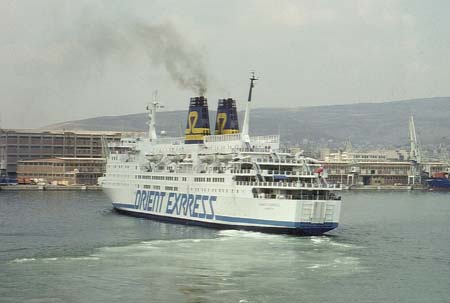
"Orient Express" in Sealink(UK) livery, Piraeus 1987 (WS)
|
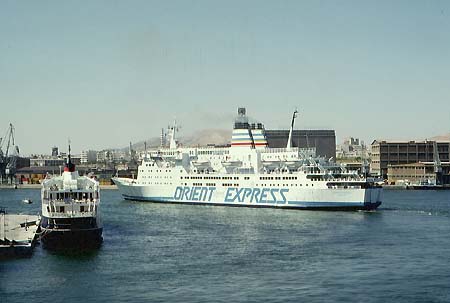
"Orient Express" in Eurosun livery, Piraeus 1990 (WS)
|
Decline and Restart
Egyptian President Nasser had organized the United Arab Republic, uniting Egypt and Syria, but it lasted only from 1958 to 1961. Nevertheless the "Algazayer" and "Syria" (4,423 gt) of 1962 replaced the "Nefertiti" of the Khedivial Mail Line on the Marseilles route under the new label United Arab Maritime Co. Then the "Algazayer" and "Syria" continued Naples services under their new designation Egyptian Navigation Co. The Federal Arab Maritime Co. provided Limassol - Beirut - Alexandria car ferry services with the "Alzahraa", the Alexandria Shipping Co. with the "Al Anoud" and Demline of Lebanon connected in the 70s even Marseilles with the car ferry "Liban".
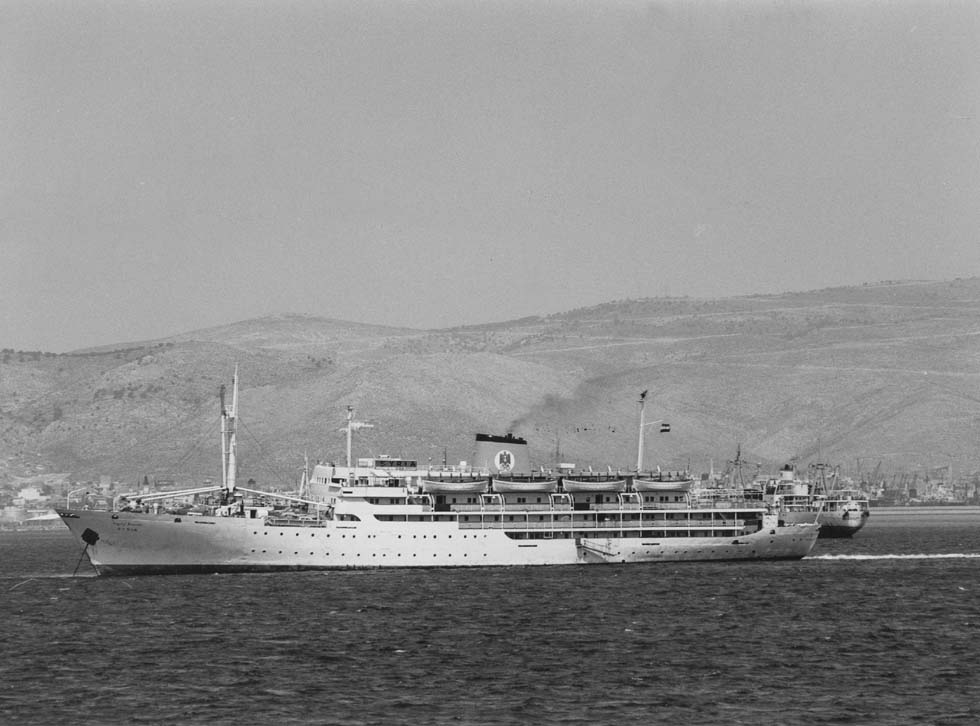
"Syria" of Egyptian Navigation Co., Piraeus 1981 (WS)
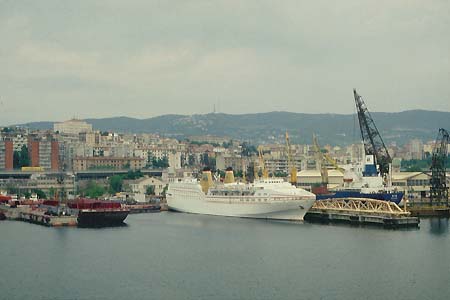 The rebuilt "Egitto Express", Trieste 2004 (WS)
The rebuilt "Egitto Express", Trieste 2004 (WS)
Egypt under President Sadat concluded the peace treaty with Israel in 1979. From that time it was combated by extremists, culminating in the attack on the cruise ship "Achille Lauro" in 1985. In the last decade of the 20th century, passenger shipping and car ferries have virtually disappeared from the utmost southeast of the Mediterranean. For Adriatica, the ferries "Palladio" and "Sansovino" (10,977 gt) were built in 1989, announced for a seasonal Venice - Alexandria service. Cook's timetable however showed no longer any passenger ferry route to Egypt, Israel or Lebanon. Adriatica's "Egitto Express" was employed temporarily on Tirrenia's Ancona - Split route, state-owned like Adriatica, which disappeared.
The Cyprus war of 1974, initiated by the second Greek military junta, had divided that island. Cyprus reportedly has become a "paradise" for Greek tax-payers, but no car-ferry connected it with Greece. Cook listed in 2005 still a Turkish Maritime Lines route from Mersin to Famagusta in northern Cyprus. Fen Fergun started car ferry and passenger catamaran services from Tasucu in Turkey to Girne (Kyrenia) on the northern coast of the island. Limassol remained the harbour of the south. About Poseidon Lines of Greece with their car ferry link Piraeus - Limassol - Haifa, Cook wrote in November 2005: "Service suspended". Concerning Salamis Lines, the Internet listed a service Greece - Cyprus - Port Said with the "Salamis Star", but in late 2011 a note stated: "suspended until further notice". Salamis Cruise Lines however worked. Years ago South Cyprus had voted against reunification, but the EU tried to end the reciprocal blockade of ports and airports.
The Turkish Maritime Lines service Brindisi - Cesme ceased in December 2005 and the traditional flag carrier disappeared from the timetables a few years later. During decades Turkey could not have been reached by any ferry from Greece, though Turkish president Erdogan and the Greek government finally had built up friendly relations. Little Turkish or Greek boats provided connection with neighboring Greek islands. Sanline tried in 2004 a Brindisi - Cesme route with the "Istanbul S", the former "Torres" of Tirrenia, then renamed "Sancak S". Marmara Lines offered a service from Ancona to Cesme, followed by a Mesline service Brindisi - Cesme. The "Samsun", formerly employed on the Venice - Izmir route of Turkish Maritime Lines, could have been watched on cruises for Cruise & Ferry Line Deniz in the Aegean. Istanbul Deniz Otobusleri (Ido started providing, apart from their local services, connections along the Marmara and Aegean coast. Their "Mavi Marmara" (1994/ 4,142 gt) became famous when she, acquired by the political organization IHH, was captured in 2010 by Israeli military forces during an attempt to break through the Gaza blockade. Various enterprises are maintaining services on the eastern coast of the Aegean. Bodrum Express Lines opened passenger hi-speed services from Bodrum to Greek islands with Kometa and Voshkod type hydrofoils. Marmaris Ferry introduced on the Marmaris - Rhodes route the catamaran "Marmaris Express". And still a different "traffic" emerged with the rising tide of illegal immigrants, focused on the straits between the Turkish coast and Greek islands. In Patras they tried to enter trucks waiting for being ferried to Italy, but then this traffic was blocked by enforced police controls.
The Lebanese civil war has ruined trade and shipping in the Levant. Syria decided later for a neutral status. In 1973 its main port of Al Ladhiqiyah (Latakia) was connected by rail with the interior of the country, so being no longer dependent on the port of Beirut. In the first decade of the 21st century, the Turkish enterprise Merlat Denizcilik tried a service from Mersin in Turkey to Ladhiqiyah. In 2010 at long last a service to Lebanon was started by Fergun Shipping of Turkey.
Concerning Israel, merely in 2000 the "Konstantin Chernenko" undertook some voyages from Odessa to Haifa for Jewish emigrants. After in 2006 the Iranian-Lebanese Hezbollah organization attacked Israel, which responded by bombing Beirut airport, there was another sort of passenger service: People were evacuated from Lebanese ports to Cyprus by ferries and small cruise ships leased from several nations.
As long as the existence of Israel is menaced, the economy on the eastern shore of the Mediterranean cannot fully develop. Nevertheless Cook's timetable listed Salamis Lines cruises to Haifa, larger cruise ships appeared, too, and finally some hope seemed to emerge for the once so important shipping routes in the Eastern Mediterranean. In 2008 Business Stories (20 July) reported about activities of Emanuele Grimaldi: "With Minoan he is targeting to connect the Western with the Eastern Mediterranean and the Black Sea". In the meantime, competitor ANEK advertised Champion Ferries cargo ro-ro services from Piraeus to Alexandria and to Haifa. Trade could emerge, but in 2011 the events in Egypt and the disputes about natural gas resources in the Eastern Mediterranean called stability once again into question.
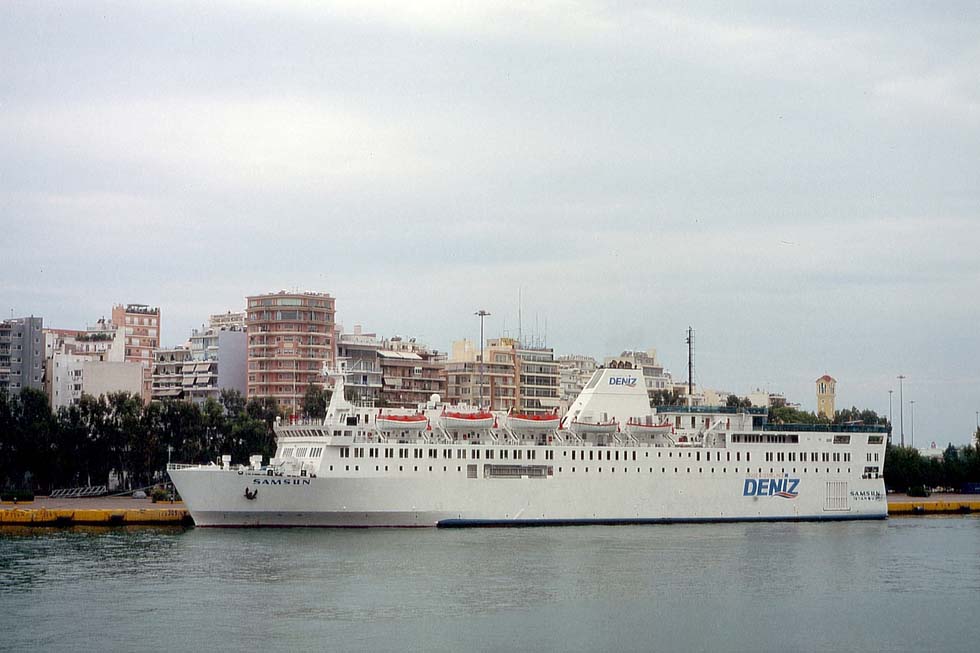
"Samsun", formerly of Turkish Maritime Lines, Piraeus 2008 (WS)
|